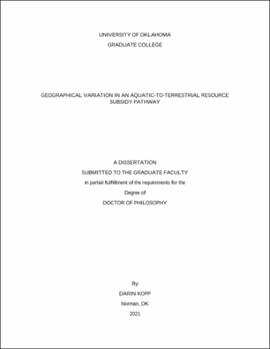| dc.description.abstract | The redistribution of energy and materials across ecosystem boundaries (i.e. resource subsidies) can have substantial consequences for ecosystem processes but the magnitude of these effects are known to vary. Since most investigations are conducted at local spatial scales our understanding of whether, and how, geography underpins this variation is limited. Aquatic insects that metamorphose into terrestrial adults, shuttle resource subsidies from aquatic ecosystems to terrestrial ecosystems. My dissertation explores how aquatic insect resource subsidies can vary geographically because of regional differences in 1) the shape of aquatic ecosystems, 2) the trait-composition of aquatic insect communities, and 3) the quantity of insect biomass exported from streams and rivers. Finally, to integrate these findings with previous studies, I also explore geographical variation in scaling functions that can be used to transfer information from one scale to another.
In chapter one, I investigate how climate, topography, lithology, and vegetation could drive variation in stream network geometry and constrain the spatial extent of aquatic insect subsidies at the continental scale. The geometric properties of stream networks could influence the spatial extent of aquatic subsidies by influencing the degree of contact between the water and land. I found that some level of aquatic insect subsidies can travel throughout the entire terrestrial ecosystem and is strongly influenced by the drainage density (the length of streams per unit watershed area) of the stream network. In turn, drainage density varied across the contiguous US and was strongly influenced by overland runoff. These results suggest that the spatial extent of aquatic insect subsidies in terrestrial ecosystems varies geographically because of the geometry of the stream networks.
In chapter two, I synthesize aquatic biomonitoring and biological trait data to quantify the relative importance of several environmental gradients on the potential spatial and temporal characteristics of aquatic insect subsidies. Species traits related to the development and dispersal of adult aquatic insects should determine their availability to terrestrial consumers. I found trait composition of benthic macroinvertebrate communities varies among hydrologic regions and could affect how aquatic insects transport subsidies as adults. Further, anthropogenic impacts could modify the natural variation in community trait composition by decreasing the frequency of individuals with adult flight and extending the distance subsidies travel into the terrestrial ecosystem. These results suggest that natural and anthropogenic gradients could affect aquatic insect subsidies by changing the trait composition of benthic macroinvertebrate communities across large spatial scales.
In chapter three, I investigate how the quantity of aquatic insect subsidies exported form streams and rivers in the contiguous United States could be altered by climate change. I estimate that streams and rivers can export 78,197 (95% PI: 2,155 - 2.19 x 106) metric tons of insect biomass and found that the effects of climate change could lead to as much as a 250% increase in some regions while others could experience a 50% decrease. I also show that these changes could resonate through terrestrial ecosystems and have consequences for common avian aerial insectivores by altering the amount of aquatic insect subsidies available to them. Collectively, these results suggest that climate change effects on one ecosystem will resonate throughout other ecosystems due to cross-ecosystem linkages.
In my last chapter, I assess whether simple scaling functions can accurately transfer information from one scale of observation to another. Scaling functions can provide a concise description of scale dependency and improve our ability to synthesize research conducted at different scales. I quantified spatial pattern of hydrogeomorphic habitat patches in riverine landscapes and investigated how it changes with different scale components: spatial extent, grain size, and thematic resolution. I found each component of scale influenced the spatial pattern in river networks and, when predictable, scaling functions took linear, logarithmic, or power forms. Contrary to previous findings from other, well-studied landscapes, our results suggest the effects of changing spatial grain may be less predictable than changing spatial extent and thematic resolution. Together, these results support the notion that scaling relationships in riverine landscapes operate differently than other ecosystems because of their dendritic form. | en_US |

